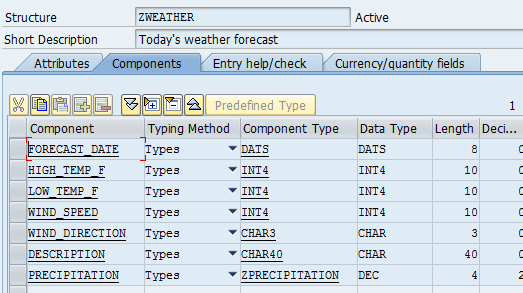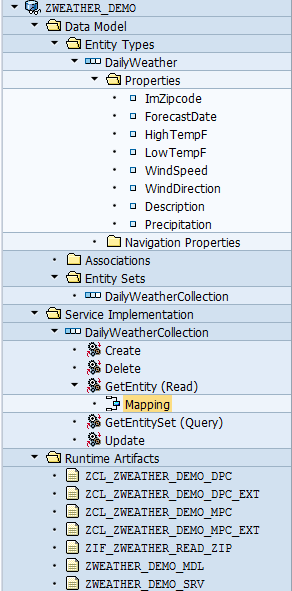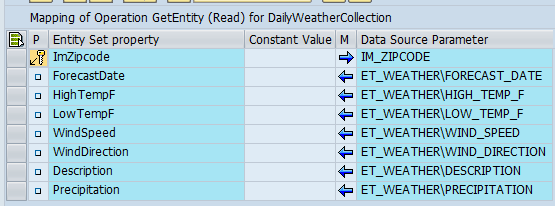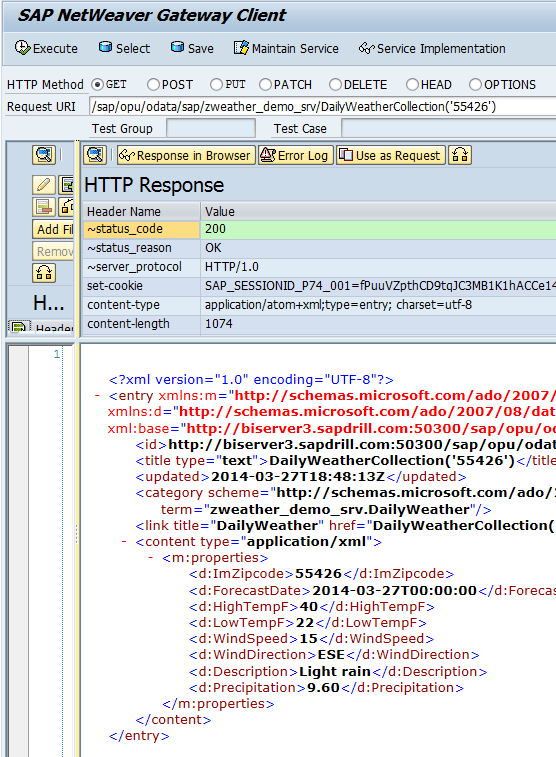Look, you don’t need to tell me. I already know the truth, deep in my bones: ABAP is not the language the cool kids use. Not even remotely on their radar. They’ve got their Scalas, and their Rusts, and all 30 billion javascript frameworks to build hot startups with. You can’t even play with ABAP unless you work for a place that runs SAP or you’re willing to download and install the massive (50 GB!) ABAP trial version.
Let me show you.
<?xml version="1.0" encoding="UTF-8"?> <data> <request> <type>Zipcode</type> <query>55426</query> </request> <weather> <date>2014-03-27</date> <tempMaxC>5</tempMaxC> <tempMaxF>40</tempMaxF> <tempMinC>-6</tempMinC> <tempMinF>22</tempMinF> <windspeedMiles>15</windspeedMiles> <windspeedKmph>24</windspeedKmph> <winddirection>ESE</winddirection> <winddir16Point>ESE</winddir16Point> <winddirDegree>123</winddirDegree> <weatherDesc> <![CDATA[Light rain]]> </weatherDesc> <precipMM>9.6</precipMM> </weather> </data>
I then set up a function module to do pull data from the service and put it into that structure:
*”—————————————————————
*”*”Local Interface:
*” IMPORTING
*” VALUE(IM_ZIPCODE) TYPE AD_PSTCD1
*” TABLES
*” ET_WEATHER STRUCTURE ZWEATHER
*”—————————————————————
DATA: lo_http_client TYPE REF TO if_http_client,
lv_service TYPE string,
lv_result TYPE string,
lo_ixml TYPE REF TO if_ixml,
lo_streamfactory TYPE REF TO if_ixml_stream_factory,
lo_istream TYPE REF TO if_ixml_istream,
lo_document TYPE REF TO if_ixml_document,
lo_parser TYPE REF TO if_ixml_parser,
lo_weather_element TYPE REF TO if_ixml_element,
lo_weather_nodes TYPE REF TO if_ixml_node_list,
lo_curr_node TYPE REF TO if_ixml_node,
lv_value TYPE string,
lv_node_length TYPE i,
lv_node_index TYPE i,
ls_weather TYPE zweather,
lv_node_name TYPE string,
lv_node_value TYPE string.
lv_service =
‘https://api.worldweatheronline.com/free/v1/weather.ashx’.
lv_service =
lv_service = lv_service && ‘&key=[use your own!]’.
cl_http_client=>create_by_url(
EXPORTING
url = lv_service
IMPORTING
client = lo_http_client
EXCEPTIONS
argument_not_found = 1
plugin_not_active = 2
internal_error = 3
OTHERS = 4 ).
lo_http_client->send(
EXCEPTIONS
http_communication_failure = 1
http_invalid_state = 2 ).
lo_http_client->receive(
EXCEPTIONS
http_communication_failure = 1
http_invalid_state = 2
http_processing_failed = 3 ).
“Prepare XML structure
CLEAR lv_result .
lv_result = lo_http_client->response->get_cdata( ).
lo_ixml = cl_ixml=>create( ).
lo_streamfactory = lo_ixml->create_stream_factory( ).
lo_istream = lo_streamfactory->create_istream_string(
lv_result ).
lo_document = lo_ixml->create_document( ).
lo_parser = lo_ixml->create_parser(
stream_factory = lo_streamfactory
istream = lo_istream
document = lo_document ).
“This actually makes the XML document navigable
lo_parser->parse( ).
“Navigate XML to nodes we want to process
lo_weather_element = lo_document->find_from_name_ns(
lo_weather_nodes = lo_weather_element->get_children( ).
“Move through the nodes and assign appropriate values to export
lv_node_length = lo_weather_nodes->get_length( ).
lv_node_index = 0.
CLEAR ls_weather.
WHILE lv_node_index < lv_node_length.
lo_curr_node = lo_weather_nodes->get_item( lv_node_index ).
lv_node_name = lo_curr_node->get_name( ).
lv_node_value = lo_curr_node->get_value( ).
CASE lv_node_name.
WHEN ‘date’.
REPLACE ALL OCCURRENCES OF ‘-‘ IN lv_node_value WITH ”.
ls_weather-forecast_date = lv_node_value.
WHEN ‘tempMaxF’.
ls_weather-high_temp_f = lv_node_value.
WHEN ‘tempMinF’.
ls_weather-low_temp_f = lv_node_value.
WHEN ‘windspeedMiles’.
ls_weather-wind_speed = lv_node_value.
WHEN ‘winddir16Point’.
ls_weather-wind_direction = lv_node_value.
WHEN ‘weatherDesc’.
ls_weather-description = lv_node_value.
WHEN ‘precipMM’.
ls_weather-precipitation = lv_node_value.
ENDCASE.
ADD 1 TO lv_node_index.
ENDWHILE.
APPEND ls_weather TO et_weather.
ENDFUNCTION.



